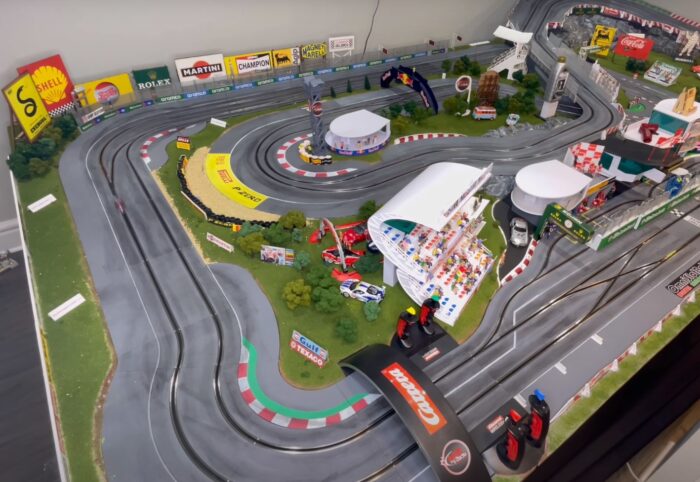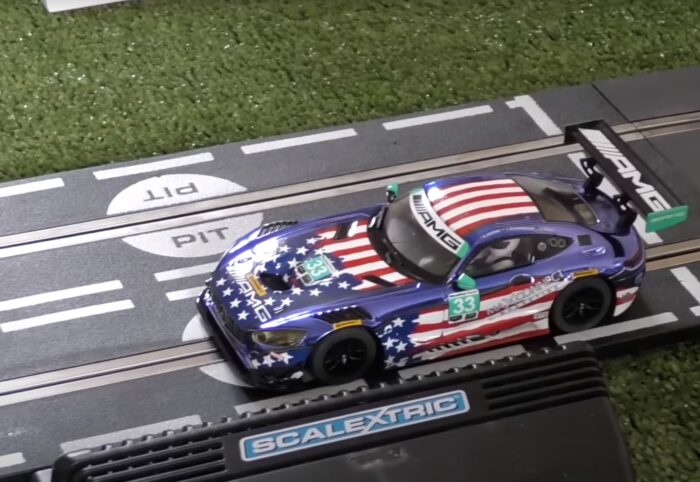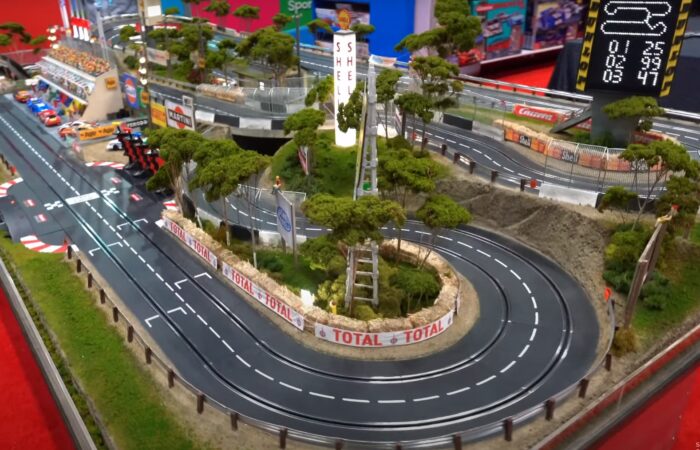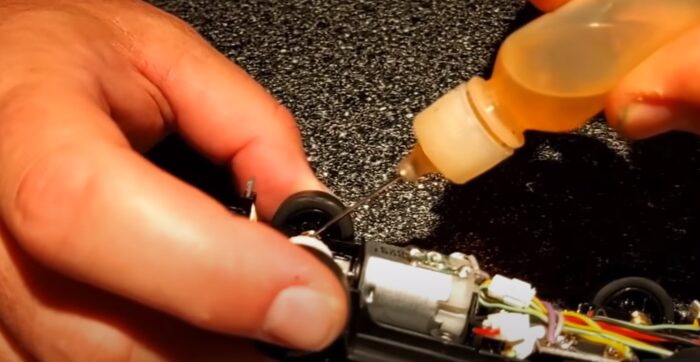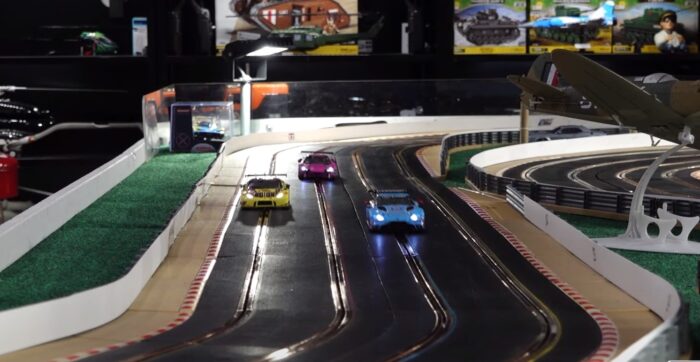Getting into Ho slot cars might seem like a seamless experience, but it isn’t always like this.
When I started with this hobby, I was fortunate enough to have my father alongside me.
I always asked him about whatever I did not understand. Not everyone is as fortunate as I was back then.
hat is why I would like to share with you a beginner’s guide that will make your first steps significantly easier.
Table of Contents
What are the Key Components?
Ho Slot cars are miniature-powered vehicles propelled along a track by a groove or slot from which they derive their name. These cars typically consist of several key components:
- The motor
- Chassis
- Body
- Axles
- Guide
The motor provides the power, driving the car forward, while the chassis serves as the frame and foundation for all other parts.
The body, often designed to replicate real-life racing cars, encapsulates the mechanical components.
Axles hold the wheels, ensuring smooth motion, and the guide, often a small blade or pin, slots into the track to keep the car in its trajectory.
Electrical components play a crucial role in the functioning of ho slot cars.
Braids, made of flexible wires or metal, provide the necessary electrical connection between the track and the car, powering the motor.
Magnets are commonly used to enhance the adherence to the track, improving stability and speed around curves.
Digital chips can be integrated into more advanced slot cars to enable racing on digital tracks, where multiple cars can share the same lane and even switch lanes.
Slot Car Scales and Types
Slot cars come in various scales, with the most common being:
- 1:64 (HO scale)
- 1:32
- 1:24
The scale of a slot car affects not only its physical size but also its compatibility with different tracks and the overall racing experience.
The smallest, the HO scale, is highly popular due to its compact size which allows for more intricate and longer tracks in smaller spaces.
On the other hand, 1:32 offers a balance between size and detail, making it favored for both casual and competitive racing.
The largest, 1:24 scale, is typically reserved for serious hobbyists and professional competitions, providing the most realistic experience but requiring more space.
The choice of scale influences the type of racing one can enjoy.
Smaller scale cars are typically faster on complex tracks with tight curves, while larger scales offer greater detail and realism, making them ideal for more straightforward, speed-focused racing tracks.
How About Tracks?
The construction of slot car tracks can vary greatly, but they generally fall into two categories: plastic and routed tracks.
Plastic tracks are affordable and easy to assemble, making them popular for casual racers and beginners.
These tracks often come in kits with ready-to-assemble pieces including curves, straightaways, and lap counters.
Routed tracks, however, are cut from a single piece of material like wood, offering a more permanent and durable solution.
Enthusiasts and those hosting competitions favor these, as they allow for more track layout and surface customization.
The material and design of the track are critical as they directly impact the RC cars’ performance. Smoother surfaces provide faster speeds, while textured surfaces offer more grip.
Maintenance is key to preserving track performance, involving regular cleaning to remove dust and debris.
Another major thing is ensuring electrical connections are consistent throughout the layout.
Driving Techniques and Tips
Mastering slot car racing requires a combination of skill, precision, and strategic thinking.
To excel, racers must develop and refine various driving techniques that optimize their performance on the track.
| Technique | Description |
|---|---|
| Handling Curves | Balance speed to maintain control and competitiveness around curves using throttle modulation. |
| Practice | Regular practice improves reaction time and familiarity with car behavior. |
| Strategic Braking and Accelerating | Use strategic braking and accelerating to navigate curves effectively and maintain momentum. |
| Experimentation | Test different speeds and methods on various track sections to optimize racing strategy. |
| Learning from Each Race | Observe competitors, seek advice, and engage in forums to enhance racing skills and strategy. |
Slot RC Car Maintenance and Customization
Maintaining slot cars is crucial for ensuring they perform at their best during races.
The process involves several important steps:
- The first step is to regularly clean the slot cars to remove any dust, debris, or residue that can accumulate during races and potentially hinder performance.
- Use a soft brush or compressed air to clean the body and undercarriage gently.
- Proper lubrication of moving parts like gears and axles reduces friction and wear, promoting smoother operation.
- Specialized lubricants should be used sparingly to avoid attracting dirt that could gum up the mechanisms.
- Regular inspection of your car’s components is essential.
- This includes ensuring that the chassis is straight and undamaged, the motor delivers consistent power, and all connections are secure.
- Any loose or damaged parts should be tightened or replaced as necessary.
- Components like tires, braids, and gears wear out with use and need to be replaced periodically.
- Worn tires can significantly impact traction and speed, while old braids may cause poor electrical connectivity to the track, affecting performance.
Keeping your slot car in excellent condition not only enhances its performance but also extends its lifespan, ensuring that you get the most out of your investment.
Customization of slot cars is another enriching aspect of the hobby, allowing enthusiasts to personalize their models:
- Customizing the look of your slot RC car with paints and decals is a great way to make your vehicle stand out.
- You can use model-specific paints to add color and apply decals to replicate the designs of famous race cars or create your own unique appearance.
- Modifying the body of a slot car can involve changing its shape or replacing it with a custom-designed shell to improve aerodynamics or just enhance its visual appeal.
- Beyond aesthetic changes, serious racers often upgrade various components of their slot cars.
- This can include installing a more powerful motor, lighter or more durable axles, and better-performing tires.
- These upgrades can significantly affect the car’s speed, handling, and reliability on the track.
- For those with technical expertise, adding digital chips for enhanced control or integrating lighting for aesthetic effects can also be considered.
- Such modifications allow for a more interactive racing experience and can provide an edge in competitive racing scenarios.
Getting Started with Slot RC Car Racing
For newcomers eager to dive into slot car racing, choosing the first set can seem daunting. It’s advisable to start with a simple, manageable system—typically a basic 1:32 scale track and car.
The scale offers a good balance of size, cost, and ease of use.
Beginners should look for sets that include everything needed to start racing right out of the box, including:
- Controllers
- Power supplies
- Selection of track pieces.
Initial setups should focus on simpler track layouts. It helps in understanding the basics of slot car control and track maintenance before moving on to more complex systems and layouts.
As your skills develop over time, you can expand their setups or upgrade to more advanced cars and tracks, continually enhancing their racing experience.

